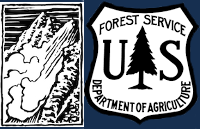On 4/18/22 near Cooke City we witnessed natural rollerballs and pinwheels by 11 am, and a couple wet loose slides below cliffs on southerly slopes around noon, and were able to easily trigger pinwheels on west-southwest aspects around 1230-1pm. Photo: GNFAC
21-22
Natural and skier triggered small new snow slides
On 4/17/22 near Cooke City we saw a couple natural 2-4" deep, 10' wide slabs on small hills lower down (pictured); natural 6-16" slabs on heavily wind loaded slopes on east aspeaspectSheep Mtn., north face of Miller and east Wolverine mostly D1-1.5 (no photos); and two skier triggered D1.5 loose snow/storm slabs on the east aspecaspectiller Ridge (no photo).
On 4/18/22 we saw this large natural slab on east facing Mineral Mtn. around 9,800', on a wind loaded slope below cliffs. Happened yesterday or maybe this morning. Photo: GNFAC
Forecast link: GNFAC Avalanche Forecast for Fri Apr 22, 2022
On 4/17/22 near Cooke City we saw a couple natural 2-4" deep, 10' wide slabs on small hills lower down (pictured); natural 6-16" slabs on heavily wind loaded slopes on east aspect of Sheep Mtn., north face of Miller and east Wolverine mostly D1-1.5 (no photos); and two skier triggered D1.5 loose snow/storm slabs on the east aspect of Miller Ridge (no photo). Photo: GNFAC
Small skier-triggered and natural dry loose slides near Cooke City
From obs 4/16/22: "My partner and I observed relative instability (ECTP 14) on a thick ice crust on a SW-facing slope at the base of Henderson Ridge. In addition to the ppropagation there was a frfracturet the new snow interface roughly 10cm deep, which was noticeably less consolidated than the snow between it and the buried sun-crust. We did not witness any cracking or whumphing along the skin tractrack decided to ski a similar aspecaspect
As we quickly navigated across a steep, 33-degree slope, two small loose slides broke from under our cuts, each roughly 10' across and traveling 30'. Each of these broke on the shallower new snow that rendered a frafracture our ECT. "
The same day GNFAC forecaster witnessed a couple 3-4" deep, 30 foot wide very soft natural new snow slides.
From obs 4/16/22: "My partner and I observed relative instability (ECTP 14) on a thick ice crust on a SW-facing slope at the base of Henderson Ridge. In addition to the propagation, there was a fracture at the new snow interface roughly 10cm deep, which was noticeably less consolidated than the snow between it and the buried sun-crust. We did not witness any cracking or whumphing along the skin track and decided to ski a similar aspect. As we quickly navigated across a steep, 33-degree slope, two small loose slides broke from under our cuts, each roughly 10' across and traveling 30'.
GNFAC Avalanche Forecast for Mon Apr 18, 2022
<p>Clear skies and above freezing temperatures today, and maybe later in the week, will quickly get the new snow wet and make avalanches easier to trigger (<strong><a href="https://www.youtube.com/watch?v=JqwSknw4e_E&list=PLXu5151nmAvT1nrM2…;). Anticipate changing conditions and monitor the wetness of the snow surface. Plan to be off and out from underneath steep terrain that receives direct sunshine before it becomes unstable. If you see large pinwheels of snow on the surface or can make a snowball of moist snow, it is time to retreat to lower angle or shadier terrain.</p>
<p>Over the weekend recent new snow created dangerous avalanche conditions, especially where it was drifted into thicker, dense slabs by strong wind. We received reports of natural avalanches in the Bridger Range (<strong><a href="https://www.mtavalanche.com/images/22/natural-avalanches-northern-bridg…;) and Cooke City (<strong><a href="https://www.mtavalanche.com/images/22/natural-avalanche-fin">photo</a><…;) which broke during and immediately after the heaviest snow fell on late Saturday. On Saturday in East Rosebud Creek, outside our advisory area, five skiers from two separate groups were caught in a natural dry loose snow avalanche. Luckily, no one was injured. The avalanche became large as it entrained snow while it swept down the couloir they were climbing (<strong><a href="https://www.mtavalanche.com/node/26486">details</a></strong>). Yesterday near Cooke City, skiers intentionally triggered a 4-16” deep slab of wind drifted snow (<strong><a href="https://www.mtavalanche.com/node/26494">photo and details</a></strong>) as they descended a slope.</p>
<p>This week similar avalanches are possible which will involve the recent snow or snow that falls later this week. Watch for signs of unstable, wind-drifted snow and avoid steep slopes where you suspect it exists. Be especially cautious in terrain where even a small slab or loose snow slide would be deadly due to higher consequences, like potentially pushing you into rocks, trees or over cliffs. Before skiing or riding in steep terrain, dig down a couple feet and assess the stability of snow that fell over the last week. Avalanches could break on hardness differences within the recent snow, or on a hard melt-freeze crust buried below the recent snow. In isolated, colder areas, avalanches could break on weak layers 1-3 feet below the new snow.</p>
<p>Always follow safe travel protocols by skiing and riding with a partner, carrying a beacon, shovel and probe and exposing only one person at a time to avalanche terrain.</p>
<p>We will issue spring snowpack and weather updates each Monday and Friday through April, or as needed, and we will share relevant avalanche and snowpack information on our website and social media. If you get out, please send us your observations no matter how brief. You can submit them via our <a href="https://www.mtavalanche.com/node/add/snow_observation"><strong>website<…;, email (<a href="mailto:mtavalanche@gmail.com"><strong>mtavalanche@gmail.com</strong></a…;), phone (406-587-6984), or Instagram (#gnfacobs).</p>
Announcements, Avalanche Education and Events
Bridger Bowl is closed, and backcountry conditions exist. There is no avalanche mitigation or ski patrol rescue. In case of emergency, call 911. Please stay clear of work areas, snowmobiles, chair lifts and other equipment. Without the daily avalanche mitigation efforts of the ski patrol, backcountry conditions now exist within the boundaries of Bridger Bowl (video).
